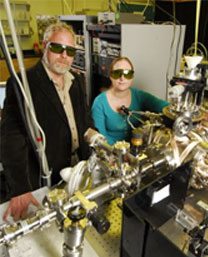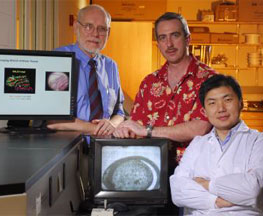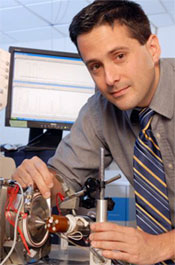ATLANTA, Ga., Sept 26, 2008 -- Georgia Institute of Technology researchers from the Colleges of Sciences and Engineering have joined forces to create the Center for Bio-Imaging Mass Spectrometry (BIMS), which aims to tackle molecular complexities of biological systems.
Understanding biology at the systems level is difficult, especially when studying complex specimens like tissue slices or communities of organisms in a biofilm. Scientists must be able to identify, quantify and locate the molecules present in the samples.
"We organized this center in 2007 when we saw the enormous potential of mass spectrometry imaging tools and realized that we had a unique ensemble of people at Georgia Tech that would enable us to excel in this field," said Al Merrill, a professor in the School of Biology and the Smithgall Chair in Molecular Cell Biology.
Georgia Tech School of Chemistry and Biochemistry professor Thomas Orlando and graduate student Irene Anestis-Richard conduct an experiment with the single photon ionization mass spectrometer.
Mass spectrometry imaging is a powerful analytical technique with the potential to unravel the molecular complexities of biological systems. It allows researchers to visualize the spatial arrangement and relative abundance of specific molecules – from simple metabolites to peptides and proteins – in biological samples.
The technique also takes advantage of the ability of biological molecules to be converted into ions that can then be separated and analyzed by a mass spectrometer. When data are collected from different regions of a sample, the distribution of molecules can be used to create multidimensional images of that sample.
Today, a popular method for studying biological samples is matrix-assisted laser desorption/ionization mass spectrometry (MALDI-MS). In this technique, sample preparation plays a very important role in image quality because it requires that a matrix compound be uniformly deposited over the surface of a histological tissue slice mounted on a special plate.
A research team including Merrill, Cameron Sullards, director of Georgia Tech's Bioanalytical Mass Spectrometry Facility, and Yanfeng Chen, a research scientist in the School of Chemistry and Biochemistry, showed that the homogeneity of the matrix could be improved. With this development, broader categories of compounds, such as lipids, could be analyzed.

Professor Al Merrill, principal research scientist Cameron Sullards (left to right standing) and research scientist Yanfeng Chen display mass spectrometry results.
The researchers used an oscillating capillary nebulizer to spray small droplets of matrix aerosol onto the sample surface – a process similar to airbrushing. Using histological samples provided by Timothy Cox, a professor of medicine at the University of Cambridge, the researchers could profile and localize many different lipid species in the samples. Specifically, they localized sphingolipids that accumulate in the brain when there is a genetic defect. This research was funded by the National Institutes of Health.
While MALDI samples must be analyzed in a vacuum, recent advances allow samples to be studied under ambient conditions. Facundo Fernandez, an assistant professor in the School of Chemistry and Biochemistry, has been using a technique called desorption electrospray ionization (DESI).
With DESI, a high-speed, charged spray containing alcohol and water is directed at a sample a few millimeters away. The solvent droplets pick up portions of the sample through interaction with the surface and then form highly charged ions that can be analyzed.
Fernandez and his research team recently used DESI to analyze nearly 400 drug samples provided by public health authorities to identify counterfeit anti-malarial drugs. Georgia Tech's efforts to develop faster analytical techniques were sponsored by the US National Science Foundation, while the sample analysis was supported by a small grant from the World Health Organization.

Facundo Fernandez, an assistant professor in Georgia Tech’s School of Chemistry and Biochemistry, recently used mass spectrometry techniques to detect counterfeit anti-malarial drugs.
"We have done a lot of work using DESI to analyze pharmaceutical formulations, but we are moving into new avenues of research including looking at algae samples, as well as ovarian cancer tissue samples provided by the Ovarian Cancer Institute, which is housed at Georgia Tech and headed by School of Biology chair John McDonald," noted Fernandez.
In ovarian cancer research, little is known about how biomarkers and low-mass signaling molecules increase or decrease in abundance with treatment. Fernandez has teamed with Thomas Orlando, chair of the School of Chemistry and Biochemistry, to use DESI and laser desorption single photon ionization mass spectrometry (LD/SPI-MS) to investigate this issue. Because the two techniques overlap in mass ranges, using both provides a more complete investigation of the biomarker profiles, says Orlando.
Because it does not use a matrix, LD/SPI-MS can detect low-mass molecules – such as sugars, amino acids, small peptides and cytotoxic compounds – formed as result of cancer treatment. It could achieve higher spatial resolution and sensitivity than typical commercial mass spectrometers that rely on the laser desorption of ions, according to Orlando.
"We hope LD/SPI-MS will lead to a better understanding of the molecular basis of ovarian cancer at its various stages and how treatment affects regulation of low-mass biomarkers in ovarian cancer cells," said Orlando.
Mass spectrometry experiments produce incredible volumes of data, each composed of thousands of spectra and thousands of peaks, which makes finding molecules of interest very difficult.
"We've focused on researching computational methods that can clean up, visualize and look for interesting patterns in thousands of mass spectrometry tissue images that you wouldn't necessarily be able to find or have time to find with the naked eye," explained May Dongmei Wang, an assistant professor in the Wallace H. Coulter Department of Biomedical Engineering and a Georgia Cancer Coalition Distinguished Cancer Scholar.
Wang, post-doctoral fellow Mitchell Parry and graduate students Richard Moffitt and Peter Siy are providing software systems to BIMS center users. The systems acquire the thousands of ion spectra collected from every tissue slide matrix, perform quality control and visualize the distribution of ions on the tissue matrix. The researchers then use data mining methodologies – including principal component analysis, independent component analysis and multivariate analysis – to identify and compare ions of interest present in different locations.
As a cell biologist, Merrill sees potential in the ability of mass spectrometry imaging to detect all of the important molecules that control cell behavior instead of just a few. Another advantage to mass spectrometry is the ability to test whether all of the cells are being affected in the same ways.
His laboratory uses mass spectrometry to profile sphingolipids, a family of thousands of metabolites that are involved in cell-cell communication and intracellular signaling. He also studies the types and amounts of these metabolites that control whether cells grow or die.
"With mass spectrometry, we have not only been able to profile these compounds, but also to find new metabolites we think are important in inflammation, aging and cancer," added Merrill.
The BIMS center at Georgia Tech includes researchers like Merrill who propose biological and clinical problems that may be solved by mass spectrometry imaging. It also brings together researchers who are improving current mass spectrometry imaging technologies and developing innovative techniques, and researchers who are analyzing the large sets of complicated data collected by mass spectrometry systems.
With the advances in software and hardware, the use of mass spectrometry in the life sciences promises to become even more prevalent and diversified for systems biology research.
For more information, visit: www.gatech.edu